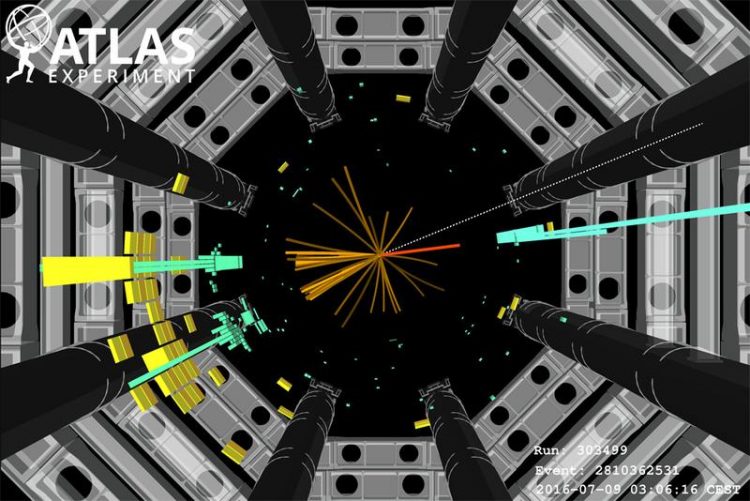Evidence of the Higgs Particle’s Decay in Quarks

The illustration shows an event that could be the sought-after decay of the Higgs particle in quarks. Illustration: ATLAS collaboration
As part of the ATLAS collaboration, the Freiburg research group led by Prof. Dr. Karl Jakobs and Dr. Christian Weiser has contributed to finding strong evidence that, among other things, the Higgs particle decays into quarks. The researchers analyzed data sets that were recorded in 2015 and 2016 with the ATLAS detector at the world’s largest particle accelerator, the Large Hadron Collider (LHC) at the European Organization for Nuclear Research (CERN) in Geneva, Switzerland.
“The strong evidence that the Higgs particle, as predicted by theory, decays into quarks provides yet another essential piece to the puzzle about this particle,” says Weiser, who leads the research activity in Freiburg. “The goal now is to prove the decay exists beyond a shadow of a doubt and, based on this knowledge, to measure the Higgs particle’s properties more accurately.”
As a result, measuring the decay is extremely important for the researchers in order to explain the short lifespan of the Higgs particle. Measurable deviations from standard theory’s predictions could point to so-called new physics, which reaches beyond the Standard Model.
The discovery of the Higgs particle through the ATLAS and CMS experiments at the LHC accelerator in CERN in 2012 presented a milestone in physics even as the particle’s existence had been predicted nearly 50 years prior to that. It is a most short-lived particle that decays into other particles nearly the moment it is produced.
The rate with which decays into various particles occur can be computed within the framework of the underlying theory. Up to now, researchers have been able to fully prove the decay into other particles – so-called W and Z bosons, photons and tau leptons. But they had not been able to observe the Higgs particle’s decay into a couple of b-quarks that is expected to occur with the largest rate of around 60 percent probability.
The reason is that a number of other processes exist that are hard to differentiate from the Higgs particle’s decay in b-quarks and that occur at a much higher rate. But now they have discovered new evidence: The probability that the observed signal is feigned solely by other processes is only 0.018 percent. The presentation of these findings was one of the highlights of the conference run by the European Physical Society (EPS) that was held July 5-12, 2017 in Venice, Italy.
Further information:
http://press.cern/update/2017/07/lhc-experiments-delve-deeper-precision
https://atlas.cern/updates/atlas-news/atlas-highlights-eps-hep-2017
Caption:
The illustration shows an event that could be the sought-after decay of the Higgs particle in quarks.
Illustration: ATLAS collaboration
Contact:
Dr. Christian Weiser
Institute of Physics
University of Freiburg
Tel.: 0761/203-5753
E-Mail: Christian.Weiser@cern.ch
https://www.pr.uni-freiburg.de/pm-en/2017/evidence-of-the-higgs-particles-decay-…
Media Contact
All latest news from the category: Physics and Astronomy
This area deals with the fundamental laws and building blocks of nature and how they interact, the properties and the behavior of matter, and research into space and time and their structures.
innovations-report provides in-depth reports and articles on subjects such as astrophysics, laser technologies, nuclear, quantum, particle and solid-state physics, nanotechnologies, planetary research and findings (Mars, Venus) and developments related to the Hubble Telescope.
Newest articles

High-energy-density aqueous battery based on halogen multi-electron transfer
Traditional non-aqueous lithium-ion batteries have a high energy density, but their safety is compromised due to the flammable organic electrolytes they utilize. Aqueous batteries use water as the solvent for…

First-ever combined heart pump and pig kidney transplant
…gives new hope to patient with terminal illness. Surgeons at NYU Langone Health performed the first-ever combined mechanical heart pump and gene-edited pig kidney transplant surgery in a 54-year-old woman…

Biophysics: Testing how well biomarkers work
LMU researchers have developed a method to determine how reliably target proteins can be labeled using super-resolution fluorescence microscopy. Modern microscopy techniques make it possible to examine the inner workings…





















